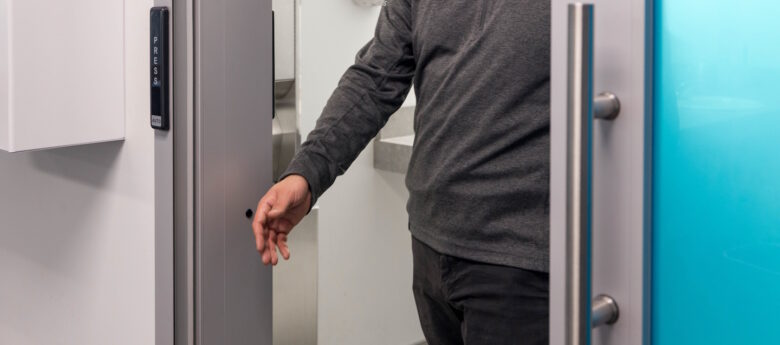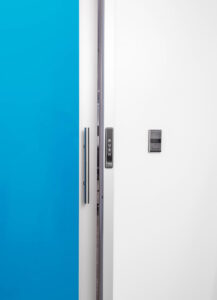Make It Automatic: Access Control Within Healthcare

For many facilities, access control is focused on points of entry into a building. However, in healthcare settings, it is often necessary to safeguard sensitive materials like patient records, medical supplies and pharmaceuticals or to control and monitor admittance into a wide range of areas. Further, the considerations for interior access control (as well as the codes around such systems) can differ significantly from those along a building’s perimeter.
Like exterior access control, it is important that interior systems are not only easy-to-use and accessible but also work with the operational needs of medical professionals. Automatic commercial sliding doors, like their manual counterparts, are space-efficient, support building accessibility and can incorporate a variety of security accessories to help manage access control within the built environment. In addition to providing access control to sensitive areas within medical facilities, these door systems open and close at determined speeds, which supports pressurized environments like pharmaceutical storage and compounding labs or offer options for hands free operation.
These systems can also be used to provide additional access control for areas that may not be required to have access control but would nevertheless benefit from it from a security or monitoring perspective.
Where Are Access Control Measures Required?
The Health Insurance Portability and Accountability Act (HIPAA) includes physical security standards for the protection of protected health information, such as patient and prescription records. These standards are commonly referred to as the “Security Rule.” Among other measures, the requirements outlined in § 164.310(a)(1) include implementing systems that limit the physical access to information systems and the facility or facilities in which they are housed.
While these systems will inevitably vary between buildings, they will almost always include hardware specifically designed to control access to these areas.
Additionally, healthcare settings that keep or compound controlled substances on site may need to follow access control standards listed in the Code of Federal Regulations (CFR). These standards are meant to guard against the theft and diversion of controlled substances. Like the Security Rule standards, CFR’s recommendations will vary between facilities due to the assessed threat level, quantity of controlled substances on hand, additional security and monitoring systems in place and other considerations. That said, most often some form of locking device will be required for these areas. For locations that compound pharmaceuticals, the standards set out by the United States Pharmacopeia (USP) may also apply. These standards outline access control requirements as well as pressure standards for minimizing the risk of spreading potentially hazardous substances.
It is important to note that not only do the requirements outlined in HIPPA, CFR and USP vary based on contextual factors but that building codes may also have additional considerations and constraints to keep in mind. As such, when determining which areas within a medical center need access control, it is a best practice to confirm with regulatory bodies (including Authority Having Jurisdiction (AHJ)) about what the exact requirements of a space are. Building code and the nature of the occupant and their use of a building can drive many additional access control requirements.

When Is Access Control Beneficial?
Not all rooms within a healthcare facility need access control, but sometimes it can be preferred. For example, limiting foot traffic in vulnerable areas like intensive care units and maternity wards can contribute to better patient experience and more positive outcomes. Likewise, for facilities that care for patients with dementia, Alzheimer’s disease and other disabilities that make wayfinding more difficult, securing access can help ensure these patients are more safe and secure.
That said, because these spaces are larger than closest or record keeping areas, they may be subject to free egress requirements listed in the International Building Code (IBC) and the various fire- and life-safety codes from the National Fire Protection Association (NFPA). As such, it is also recommended that facility managers contact an AHJ when determining the code requirements for these applications.
How Automatic Sliding Doors Enable Access Control
Automatic sliding doors are often specified to facilitate hands-free operation for a more accessible and hygienic built environment. Among the other benefits they contribute, these door systems are also fully compatible with a range of security hardware that can limit access within a healthcare setting.
For example, automatic sliding doors can incorporate locking hardware, like electric strikes or magnetic locks, that allow operation via a keypad. These systems can keep patients, visitors and non-staff from accessing sensitive areas (or accessing only with staff members with accreditation). For locking hardware with a keypad system, facility managers can both set and reset passwords easily. They can also program the functionality of the door – from fully automatic to locked. These electric locks can also be operated with a remote control to quickly change the door’s functionality. This supports a more flexible security solution as facility managers can engage or disengage locking hardware as needed.
Automatic sliding doors (and their hardware) can also be specified with backup battery power. This ensures a door will operate as intended during a power outage. When battery backup systems are installed on doors for closets, small storage areas and other spaces that are not along paths of egress, they can maintain access control even during a power outage or fire event – electrified hardware on doors along paths of egress is often required to disengage when the power goes out or fire alarms engage.
Access Control That Does More
Facility managers have several options for doors and hardware that provide additional security to sensitive areas within healthcare buildings. However, automatic sliding doors can support openings that are more accessible and space-efficient. By sidelining the need to plan for opening and operational force requirements as well as closing speeds, they help doors more easily meet requirements outlined in the Americans with Disabilities Act (ADA) requirements while also meeting door opening speed and operation recommendations stated by the International Health Facility Guidelines (IHFG).
Because sliding doors do not need space to accommodate swing arc trajectories, they can allow more useable space within the rooms they protect. This can help medical centers stay stocked on essential items or create floorplans with more patient-facing space – both of which support a more efficient medical facility. Finally, these systems include back track components that correct imperfect construction, making them compatible with retrofits as well as new construction.
Tysen Gannon, LEED AP, AD Systems, has more than 15 years of experience in the architectural products industry, including roles in sales, product management, research and marketing, with a focus on glass and glazing, fenestration and façade systems.
